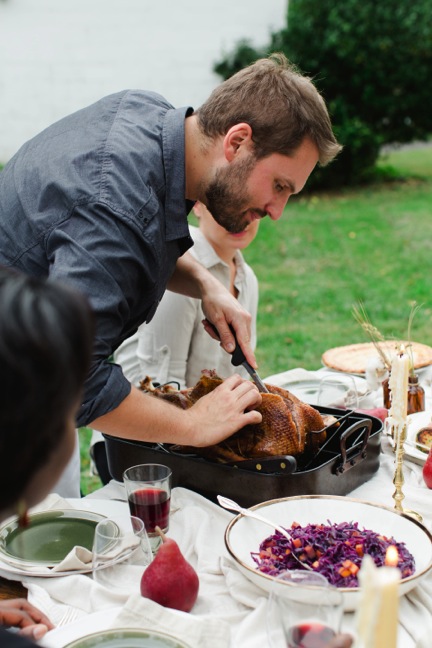Foie La La - Boundary Road on Foie Gras
/By Susan Able, EdibleDC Publisher

We caught up with Chef Brad Walker from Boundary Road, last Friday on H Street, DC’s booming restaurant corridor. Walker worked with the Edible DC team as a collaborator for our Early Winter/Holiday issue and he prepared a festive dinner for friends. As a follow-up to that article, we wanted more information on what some would think was the most delicious dish from that meal and most would call the most controversial—the foie gras.
The recipe that Walker prepared was for the whole foie gras with sautéed apples, and he says, it’s the kind of dish that defines the celebratory richness of holiday entertaining and fits right in with the other icons of the holidays: caviar, truffles, champagne, and other rich, expensive cuts of meats and game. The problem is, (and there is always a problem, yes?), that foie gras has, as NY Chef Dan Barber says, “become the most maligned of foods. If you are a chef and put it on your menu, you can be at risk of attack. The problem for us chefs is that it is so freaking delicious; it makes everything else taste better.”
Walker had been approached by PETA earlier this week with an ask to not participate or serve foie gras at the currently running second Foie La La, a holiday food festival amongst eight H Street restaurants that features this organ meat.
For Walker, one of the originators of Foie La La, this request from PETA and the promise of a protest, it was an opportunity to step back, reflect and respond. Walker sources his foie gras at Hudson Valley Foie Gras, which has a total open door policy on its foie gras production and was featured by Anthony Bourdain on his network show, the point being that they feel comfortable that their ducks are being cared for and fed in a humane way. Walker feels that all consumers of meat need to ask questions about how it is raised, and where it comes from—and that we should be asking the same questions about all of our food—including fruits and vegetables--to question whether they were produced or grown sustainably, buying as locally and seasonally as possible and with the least impact to the environment. “I respect PETA and their organization, but they are focusing on this tiny part of the meat supply—I feel like we are missing some of the larger points about problems with our food chain and commoditized meat production. We need to respect all our food.”
With a protest scheduled this afternoon, Walker still stands by Foie La La. His letter in response to PETA is here. The foie gras dish he served this week is an appetizer-size portion and was inspired by the deconstructed look, feel and taste of Thanksgiving leftovers—it has a rutabaga bread and brussel sprout base, a slice of foie gras poached in chicken fat, is topped with a fried oyster and a cranberry gastrique finishes the dish.
To prepare foie gras at home, a whole one tastes better—but it is not an inexpensive proposition. A whole foie gras from the supplier D’Artagnan is $115.99 and that would serve 4 as an entrée, 8 to 10 for appetizers, or as torchons—perhaps 30 people.
Score the foie gras in a cross hatch pattern, whether you are cooking the whole thing or have sliced large slabs for individual portions and heat a good quality pan on very high heat—throw the meat in. It is very fatty, and will immediately start to cook down. Pour the fat off as it cooks, and save it for other uses. After it gets a good sear on both sides, take it off the heat and out of the pan—let it stand on a paper towel or put it in the oven at very low heat—you want the center to be warm, but not overcooked. And that’s it. For a link to the apple foie gras recipe in our Holiday issue go here.
Chef Brad Walker, 34, is from the Baltimore suburbs, trained to be a chef at L’Academie de Cuisine in Maryland after thinking about doing anything else but cooking—including foreign service or becoming an English professor—but he’d worked in restaurants since he was 15 and knew that he could make his way around a kitchen as well as the chefs he’s watched cook. And after college, working in Colorado as a waiter and front of the house manager taught him valuable lessons in managing service and the customer experience. He cooked on the line at Cashion’s Eat Place, Fiola and Proof before opening Boundary Road in 2012.





